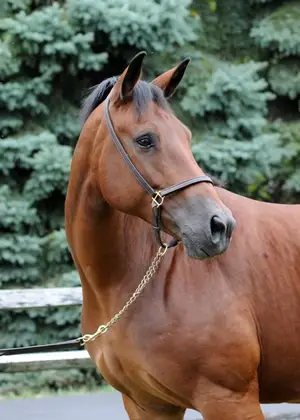History
The Cleveland Bay originated in Britain, in the Cleveland area of Northern Yorkshire, and is the oldest of the indigenous breed of English horses. Yorkshire is known as the source of two breeds, the Thoroughbred and the Cleveland Bay. The Cleveland Bay breed is thought to have evolved from crossing native bay colored mares with Oriental stallions during the 17th century. Shaped by a harsh environment, a horse of durability, longevity and quiet disposition resulted.
These characteristics, combined with the uniformity of bay color, size, and substance, developed a versatile breed used as hunt horse, coach or packhorse, and as an agricultural worker. Originally known as the Cleveland Bay, after the salesmen who exclusively used Cleveland Bays, the breed excelled as an all-arounder. During the peak of the breed's popularity in the late 1880s, the Cleveland Bay Horse Society of Great Britain published the first volume of its Stud Book, which contained stallions and mares selected for the purity of blood.
During the 19th century, some Cleveland Bays were bred to Thoroughbreds, which produced the Yorkshire Coach Horse, a carriage horse with unmatched ability for speed, style, and power. With the advent of the mechanical age, the numbers of Cleveland Bay and Yorkshire Coach horses rapidly declined. They were further decimated by use as artillery horses during World War I. The Cleveland Bay survived in the region of it's birthplace during these difficult times, but in the 1960's only five or six mature stallions were known. Due to the foresight and determination of the Yorkshire admirers, the breed has survived and numbers have grown. The Queen of England became the Patron of the breed, and her Royal Mews continues the tradition of using Cleveland Bays and cross-breeds in ceremonial duties.
The Cleveland Bay has successfully been cross-bred to Thoroughbred types to produce outstanding performance horses in dressage, driving, and jumping. It is through these quality animals that breed recognition is becoming known. With the increase of numbers of Cleveland Bay purebreds, some are competing along with breeding duties. Although listed as an endangered breed with less than 500 world wide, Cleveland Bay lovers from Britain, North America, Japan, New Zealand and Australia are dedicated to the conservation of this unique horse.
The first Cleveland Bay stallions were imported to Maryland, Virginia, and Massachusetts in the early 1800's. The 1884 Upperville Colt and Horse Show in Virginia was created to showcase Col. Dulany's imported stallion, Scrivington, and his offspring. Later William Cody, America's Buffalo Bill, chose the Cleveland Bay for his Wild West show. Western States utilized the stallions in their breeding of range horses, noting their staying quality, easy maintenance, and a match for the biggest of steers.
Behavior
Dependant on breed cross.
Function
The Cleveland Bay is a versatile horse and is still used today for many tasks, including driving and farmwork. In the 1920s, Cleveland Bays replaced black Hanoverians in the British royal stables, and both the Cleveland Bay and Cleveland Bay/Thoroughbred crosses are used as royal carriage horses today. The horses are used as heavy hunters, as they are powerful and able to carry a man weighing 250 pounds (110 kg) for a full day of hunting over large obstacles and through heavy clay. When crossed with Thoroughbreds, the resulting progeny are lighter and faster, but still strong and heavy of bone. When show jumping was first beginning as a sport during the mid-19th century, Cleveland Bays were among the initial stars. Purebred and crossbred Cleveland Bays make up the majority of the bay horses in the Royal Mews, the British royal stables, where they receive intense training to desensitize them before they are put to work drawing royal carriages.
The Cleveland Bay was used in the creation of the Oldenburg breed, because of its stamina, strength, and jumping ability. The breed was also used to create and improve the Holstein and Hanoverian breeds. In the late 18th century, the Cleveland Bay was used to create the short-lived Yorkshire Coach Horse through crosses with Thoroughbreds. These Yorkshires were used mainly to pull mail and passenger coaches, hence their name. Called by some the "New Cleveland Bay", foreigners often could not distinguish between the two breeds, and many horses registered as Cleveland Bays in European coach horse studbooks were actually Yorkshire Coach Horses. In the 19th century, the Cleveland Bay was crossed with French and Belgian draft horses to create the Vladimir Heavy Draft, a Russian breed developed to fill that country's need for a heavy draft breed.






